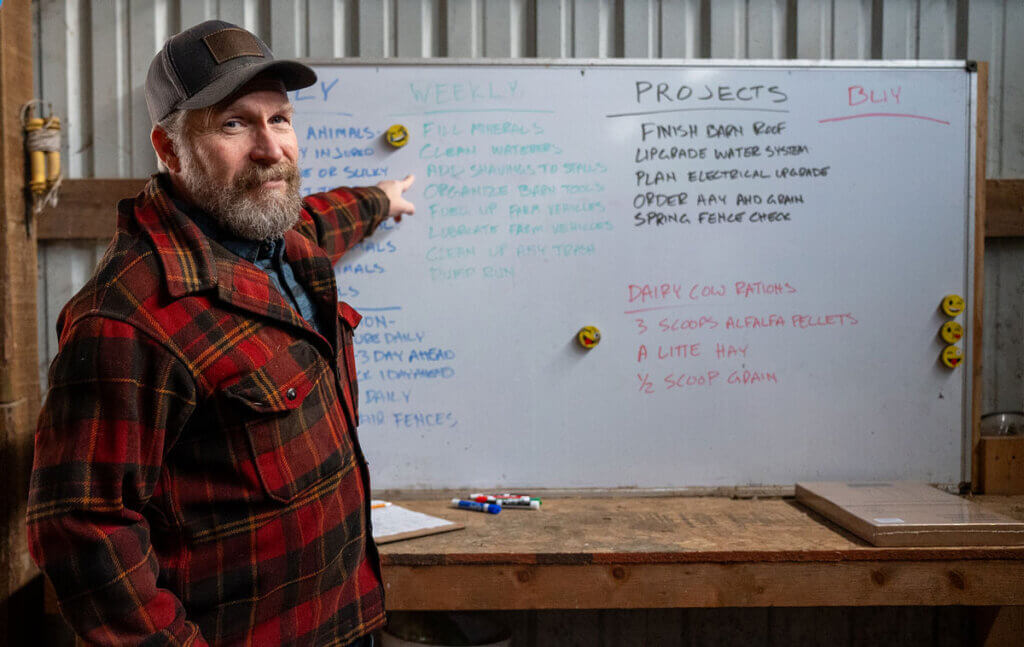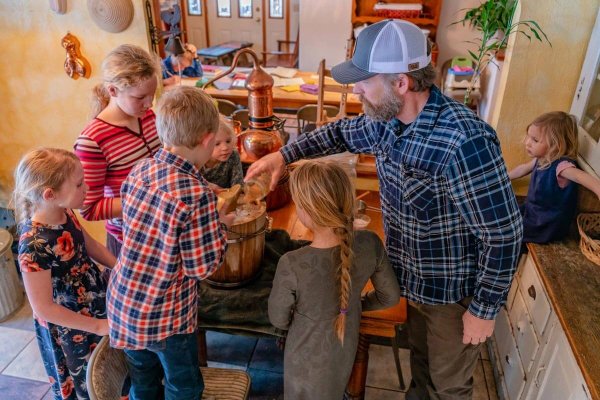The modern life is a busy one, right? Many of us are trying to stack homesteading on top of our jobs, the kids, family, and school, and it’s challenging to get it all done. This barn management system has helped our family. Learn more about how to make it work for you in this post.

Do you ever find yourself struggling to put all the pieces together? How do we get dinner on the table for the family, the homeschool education done each day, the animals fed, the pastures managed, and tend to the garden, all while maintaining a good social life within the community and having a little downtime as well?
How in the world can we make all this happen? Most of us who are living this homesteading life are very motivated, but motivation alone doesn’t get us there, and can often lead to burnout if we’re not careful.
This is where I’ve found implementing systems throughout your home and homestead can help alleviate the stress and pressure to “get it all done.” We shouldn’t (and more often can’t) do this alone. It takes a team effort. So how do we make sure the whole team here at Riverbend is on the same page?
With my barn management system…
Building Well-Articulated Systems
Having well-articulated systems is the key to managing all the tasks you must do on your homestead. This is what will help get you through the ups and downs or those times you need to have someone else step in to help.
When I say “well-articulated,” I mean a system that’s written down for all to see. Not something that’s on a clipboard or on your phone, but something in the area that multiple people can reference and work from.
The system is broken down into four main sections: Daily, Weekly, Projects and Buy.

Daily Chores
Under the “Daily” section is a list of everything that needs to happen every single day. These are tasks that can’t be overlooked and must happen each day.
- Observe the Animals – This is so important to proper animal management. When observing, we teach everyone to pay attention and look for injuries. Is the animal attentive or sulky? We look at their feet, and we assess if they are looking too thin or too fat or anything else that stands out as unusual.
- Water ALL Animals – By having this on the list, this reminds the children to think through all our animals and make sure each waterer has been topped off. When they come back to the board to check off the list, they might remember that they forgot to fill the sheep’s water.
- Feed ALL Animals – The same goes for feeding. If you’re training someone new to manage your barn systems, it might be helpful to even list out what food/grain/hay goes to which animal and how much. For us, we all know this pretty well so it’s not necessary for that to be on the board.
- Check Minerals – We feed our livestock minerals to ensure they get all the proper nutrients they need. If you want to learn more about mineralization for livestock, check out that blog post I did with Redmond Agriculture. If you need to purchase minerals, we have used and loved Redmond Agriculture (use code “HFSalt” for 15% off your order from Redmond) and Thorvin Kelp from Azure Standard for all our livestock mineral needs (for first-time Azure customers, you can use code “HOMESTEADINGFAMILY10” for 10% off your first order of $50 or more).
- Pasture Rotation – During the months when the animals are out in the pasture, this list also includes daily pasture rotation, observing the pasture, planning moves two to three days ahead of time, setting up the paddock (10 days ahead), and observing or repairing fences.

Weekly Chores
Usually our “Weekly” section is actually called “Thursday.” We like to make sure all those weekly chores are checked off the list so on the weekend we can spend more time playing and enjoying life together. If we know we’ve checked off all the items on our weekly list, this allows us to enjoy our playtime much more.
- Fill Minerals – Generally speaking, if this is getting checked on a daily basis it’s not necessary to do much on a weekly basis. But we have this here as a failsafe to make sure the minerals aren’t getting missed.
- Clean Waterers – From time to time, the waterers can get pretty nasty and need a good scrub. This chore doesn’t take long, and having it on the weekly list means none are getting overlooked for too long.
- Add Shavings to Stalls – We practice deep bedding methods with our animals and to maintain the carbon-to-nitrogen ratio. This keeps the smell down in the barn and makes for cleaner, happier animals.
- Organize Barn Tools – I’d love to say everyone puts tools back in their home after using them, but this just isn’t always the case. Once a week we do a sweep of the homestead and make sure everything gets put back in its place.
- Fuel Up Farm Vehicles – There’s nothing more frustrating than having to do a quick chore or run a quick errand and realize you’re out of fuel. Adding this task to the weekly list has almost eliminated this frustration altogether.
- Lubricate Farm Vehicles – In general, tractors and farm equipment should be lubricated after about eight hours of use. We’ve found that adding this to the weekly list takes care of it (sometimes, we can skip a week here or there, as needed).
- Pick Up Any Trash – Even though we encourage everyone to clean up after themselves, there is inevitably baling twine or other trash that gets left. A quick once-a-week sweep keeps the trash in check.
- Dump Run – It’s easy to forget there’s a truck bed full of trash. So having it on the weekly list means we know it’s getting taken care of at least once a week.

Projects
Under the projects section are items that are either a one-off task or something that may need to be done once a month or once a year.
On our current list we have the following:
- Finish Barn Roof – We’ve been in the middle of a large barn addition the past couple of years and we’re really looking forward to getting that project wrapped up.
- Upgrade Water System – There are some water system improvements we want to make.
- Plan Electrical Upgrade – During the winter months, we have to use a lot of water heaters to keep the water from freezing up and this has been causing some issues with the electricity, so we have it on the project list to see how we can improve this system.
- Order Hay and Grain – Coming out of the winter months, we’ll be quite low on hay and grain. To stay on top of that, we’ll want to make sure we’re getting what’s needed ordered.
- Spring Fence Check – It’s always a good idea when coming out of winter to do a fence check on all your fencing systems. Just to make sure everything is in good working condition. You don’t want to go put your animals out and have your animal be the one that makes you realize there’s a hole in the fence.

Buy Section
The buy section is very important. If a child is feeding the cats and notices the cat food is running low, they must add cat food to the “Buy” section on the board. Otherwise, the next time someone goes to feed the cats, the food might be gone.
This is also where we’ll add any necessary supplies or tools needed to complete anything on the project list. A project cannot be completed unless we have everything needed, so planning ahead and making sure the items are purchased and on hand means we can tackle those projects when we have the time.

Bonus Section
At any given time, we may have another section or two added to the whiteboard. We currently have a section for our dairy cow rations. One of the girls added this to the board to help her remember what to feed the cows. Since the cow’s rations change throughout the year as they’re expecting, just calved, or out on pasture, we like to keep track of what she should be getting at any given time, without needing to guess or feed from memory.

How to Use the System
All our children know that they are to check the board at least twice daily. First, to find out what needs to be done, and second to check to make sure the job is done completely. I always teach my kids that “a job is not done unless you’ve reviewed it.”
Conclusion
This is the system that works well for our family. Oftentimes, when I come out to the board there are funny little sayings written there, messages from one child to another, etc. We try to make it fun with cute little erasers and different colors for each section.

More Posts You May Enjoy
- How I Manage Our Home (Home Management Series)
- How to Prioritize Homestead Projects
- Chore Jurisdictions
- How to Stock Your Barn for Winter
- Teaching Our Children To Have a Productive Morning
- Tips for Homesteading With Children
- Daily Routine for Kids on the Homestead
- My Secret To Running a Productive Household
- Yearly Planning on the Homestead
















